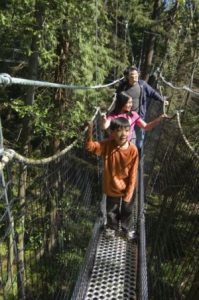Like many of us growing up on the west coast, I have fond childhood memories of exploring the rainforests of coastal British Columbia. With youthful exuberance and imagination, the forest was transformed into a playground with endless adventure waiting beyond every stone, stump and tree. Returning home thoroughly filthy was a common occurrence, with the culprit nearly always being an aggressive game of hide and go seek or capture the flag.

As I grew and came to learn more about the rainforest, my fascination with it intensified. Trees were no longer just trees; each individual species now had a unique but interconnected story. The Western hemlock (tsuga heterophylla) was no longer solely the tree best to hide under to escape the rain, it became a type of forest underdog, sprawling its sweeping branches outwards to capture what little sunlight broke through the dense canopy above. The Douglas firs’ (Pseudotsuga menziesii) story changed from that of a tree whose cones housed the tail and hindquarters of mice to a tree whose intolerance to shade left it to rely on forest fires and wind storms to clear out competing trees; its thick bark and strong wood working to protect the tree and allowing it to propagate in the sun-rich aftermath.
With time, however, the extraordinary began to fade into the ordinary. As I assume happens with many other Vancouverites, this fascination with the natural areas around us wanes. Stories are forgotten in the hustle and bustle of our daily lives and the century old stands of rainforest we encounter everyday around Vancouver become commonplace, serving as a familiar backdrop to daily life.
What happened to the unbridled wonder and excitement of exploring the forest? Did we learn all we needed to learn about the forests around us, or perhaps did Vancouver’s abundance of natural beauty simply overstimulate our sense of wonder, leaving us desensitized to the biodiversity of our own backyard? More importantly, in a fast-paced electronic world is there enough in the natural world to engage us enough to pull us away from our busy lives?
Tucked away on the southwest side of the UBC Campus, the UBC Botanical Garden offers a rare chance to rediscover the wonder and excitement of the coastal rainforest. Walking through the back of the gardens in the second-growth temperate forest, you can’t help but notice a trail unlike any other. Suspended high in the trees, the Greenheart Canopy Walkway’s bridges and platforms offer access to the forest canopy and to a view unlike anything you’ve seen before.

The bridges of the Canopy Walkway are every adventurer’s dream. With your first steps onto the suspension bridge, you are keenly aware that this is not your typical walk in the park. The design of the walkway is engineered to be non-invasive and uses a unique cable system attached high in the trees to suspend the bridges and platforms. By not using nails or bolts to suspend the walkway, the bridges have a degree of sway to them, causing your adrenaline to pump and your sense of adventure to soar. Upon reaching the stable platforms, you are able to immediately see an entirely new perspective on a familiar forest. The sword and bracken ferns (Polystichum munitum and Pteridium aquilinum)on the forest floor take on a new form from above, sprawling outwards in symmetrical circles and carpeting the forest floor. The sparse and sprawling beaked hazelnuts (Corylus cornuta)seen from the forest floor transform into competitive, canopy-dense shrubs when seen from a bird’s-eye view.
The platforms of the walkway ease you into the canopy of the large conifers. A series of ten suspension bridges let you gently ascend from 20 feet (6 meters) above the forest floor to just over 50 feet (15 meters), with an optional 70 foot (22 meter) observation platform as an added bonus for those brave enough.
The walkway’s aerial shift in perspective is the key in beginning to rediscover the rainforests in our own backyard. Standing on a platform 50 feet up the side of a 140 foot Douglas fir, you are humbled at the potential of these trees and can only attempt to imagine a coastal rainforest at its prime. You can’t help but imagine what Vancouver must have looked like hundreds of years ago, when giant stands of 300 foot tall Douglas fir and Sitka spruce rivaled the height of the skyscrapers in downtown Vancouver today.

In an environment like this, with all its unfamiliarity and exhilaration, it seems we can still experience the wonder and excitement in exploring our backyard’s biodiversity after all. Perhaps sometimes all it takes is a new perspective to truly appreciate the environment around us.
